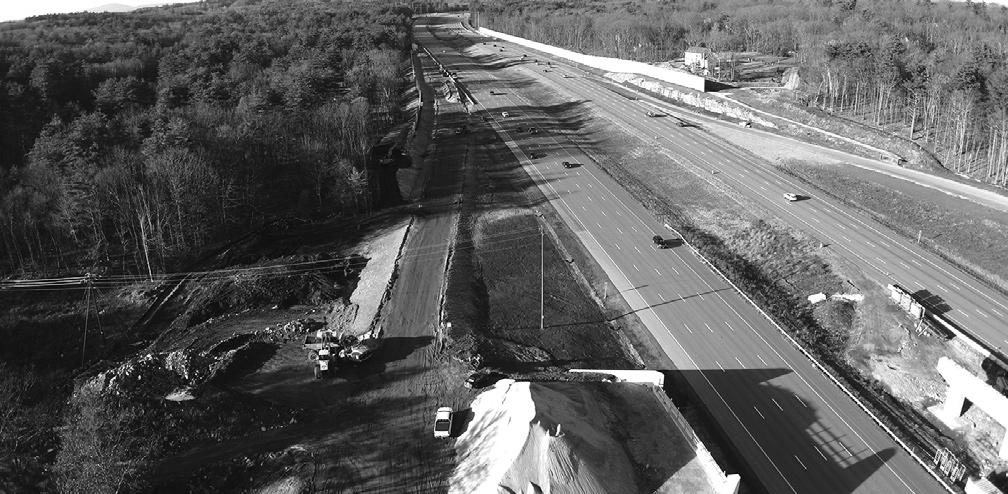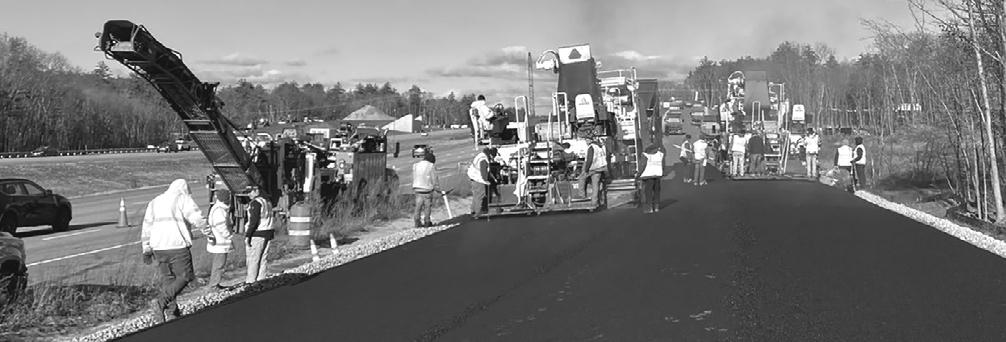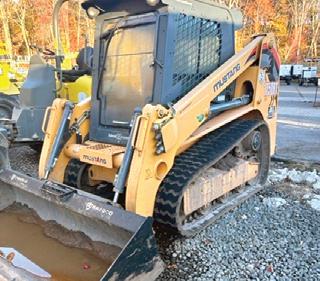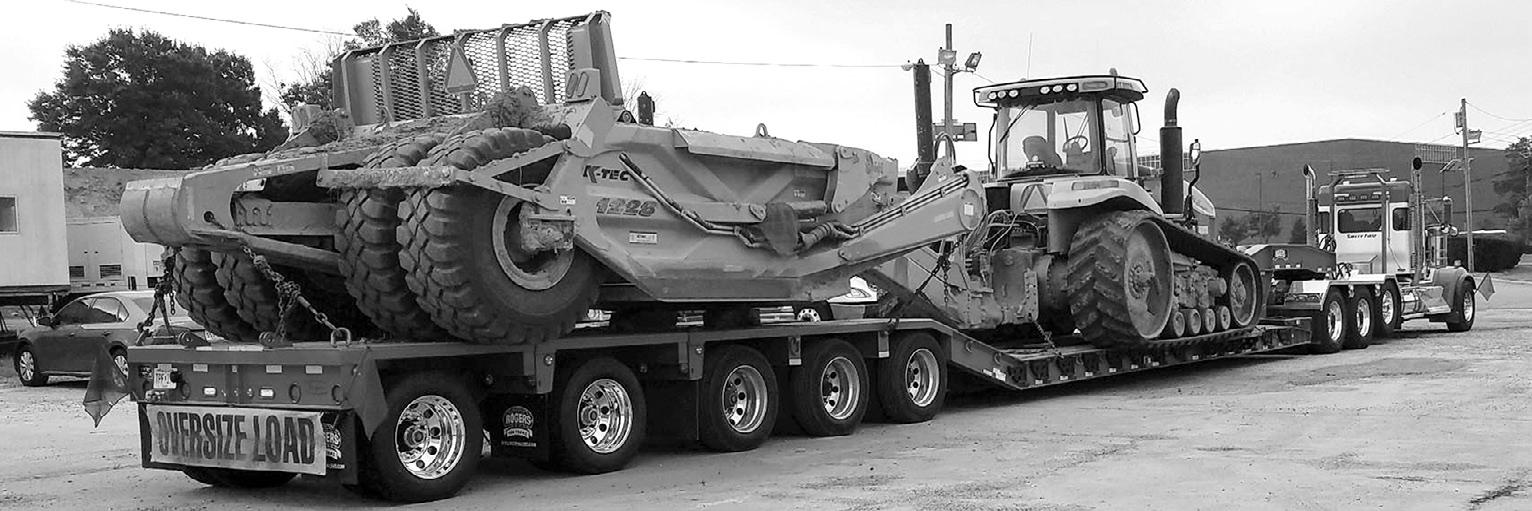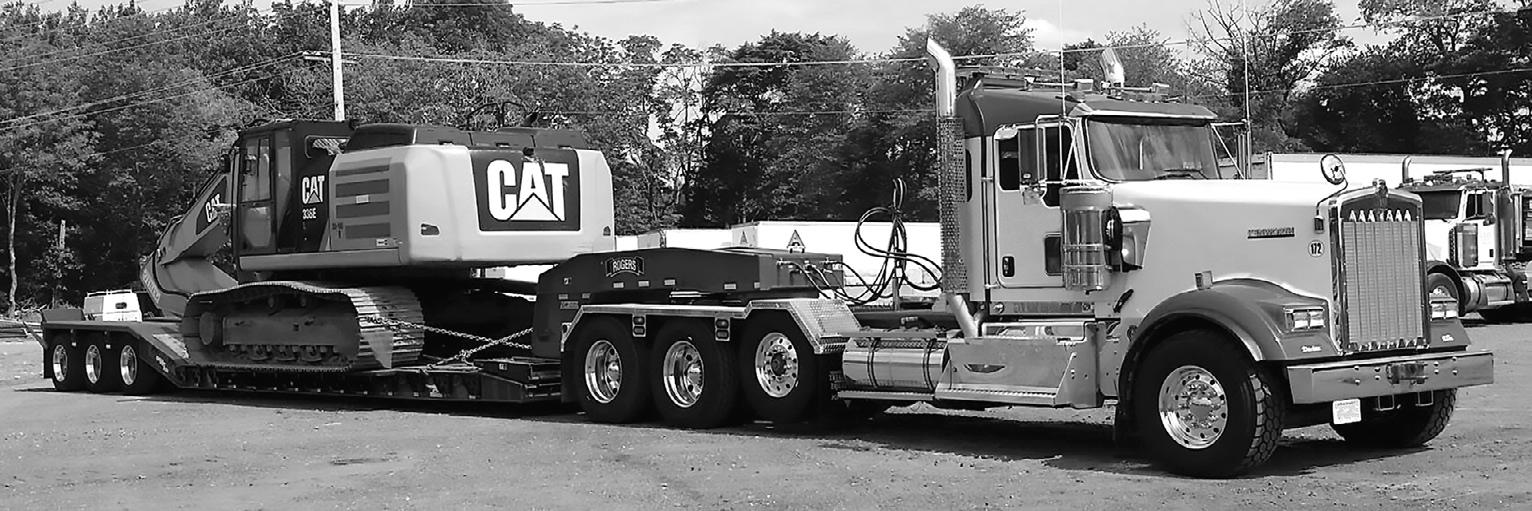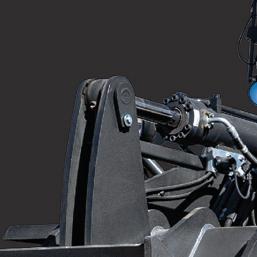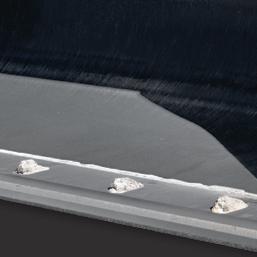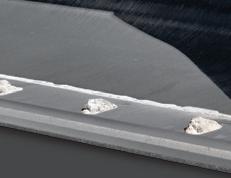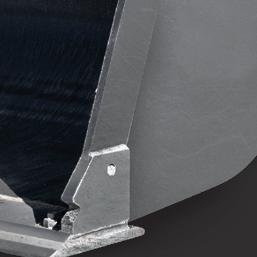




















After design was completed for three large construction and two building demolition projects in Londonderry, N.H., much of the construction of a new interchange for Exit 4A on I-93 is under way.
Weaver Brothers Construction Company of Bow, N.H., was the low bidder with a $45.5 million price tag and became the lead contractor on the project, which has a total project cost of $61.6 million with design and utility relocation costs included; 80 percent of the cost is covered by a federal grant with 20 percent coming from state turnpike toll revenue.
Spear Brothers Building Salvage and Wrecking of Laconia, N.H., was the low bidder on the demolition portion of the job, which was completed in 2023 and allows for construction of the interchange to advance more rapidly, according to NHDOT.
see INTERCHANGE page 12
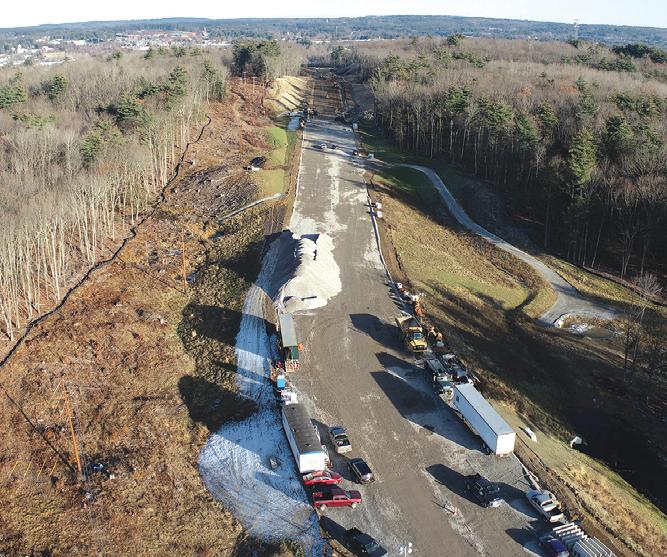
One way or another, the 192-year-old Bel Air Dam’s days are numbered.
The Pittsfield, Mass., barrier’s practical use as a power generator ended long ago, and it is now an active public safety and environmental hazard silently threatening the city’s North End and West Side.
Successive state inspections have declared the dam to be “unsafe,” and if that is not argument enough, the water spraying through gaps in the barrier’s retaining wall — especially when it rains — is particularly alarming. So is the bulge that
inspectors detected in the masonry dam.
The only question remaining is: How and when will it be demolished?
Officials have known for decades that the Bel Air Dam is a potentially life-threatening hazard, the Berkshire Eagle reported March 11.
State officials took its late owner to court 14 years ago in an effort to kick-start maintenance or demolition, to no avail.
Given its location on the West Branch of the Housatonic


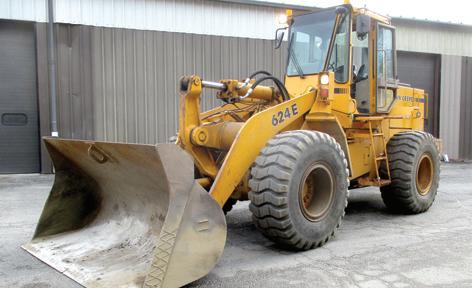
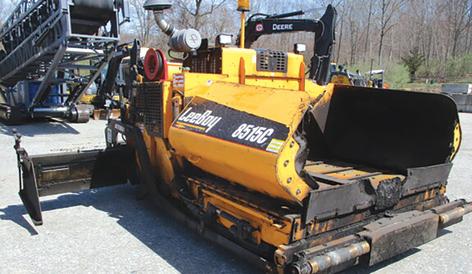


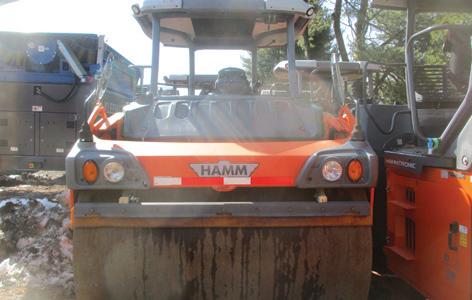

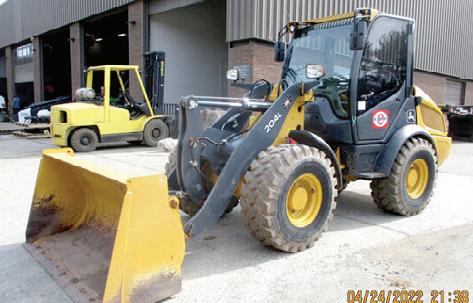
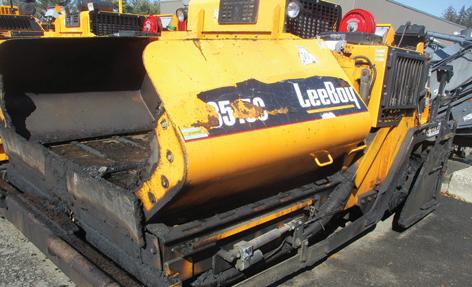
SENNEBOGEN, in kee philosophy to maxim created UPTIME Kits
eping with their mize uptime, has Whether you are a service technician i road, these kits have need for every service and PM task in one p created to save you t Managing hundreds o parts, from belts and and special tools bec single part number to n-house or on the everything you e, maintenance place. They were ime and money. of related service d nuts to O-Rings omes easy with a o order and stock


They are:










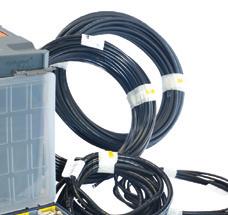






components and too
• Ideal for stocking se and trucks
Choose from the follo
• Central lubrication
• Preventive mainte
• O-Ring kits
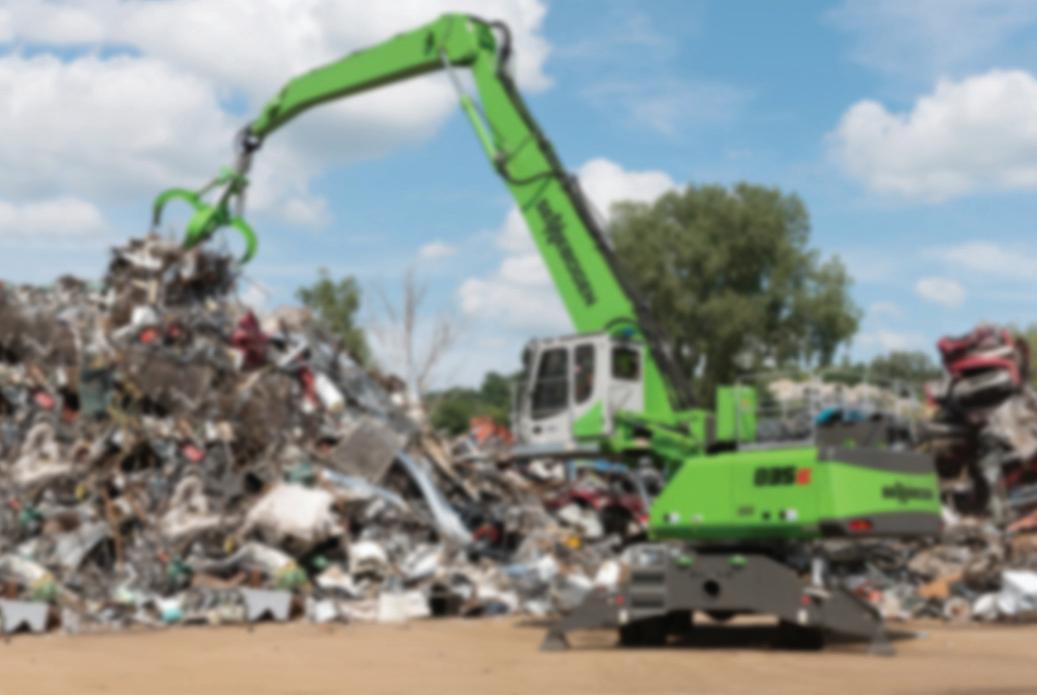

• Hydraulic
k
And the best thing is in stock and ready to built to match your m and series. Count on
SENNEBOGENin-house. For more in UPTIME Kits, scan th s that these kits, go, are custommachine model
nformation on he QR code.


• Easy to order and ea t d t stock asy to s l dow NO
If back. to front every come t a have They echnician machine, wntim warehouse. American ready-to-ship of inventories plete for uptime izes
North our in parts com with customers maxim commitment h about more Read ontract Demolition C st in parts repair the have virtu and I machine another in
aftersale Machine” he “Beyond our ow , Bloomfield Hills, MI or quickly. back unit the g I k they Since do no lose ally bring just [they] situation, a have I over go to month a once through wntime… ock. get
• Electrical service k Hydraulic service k :kits shops ols ervice owing kits system kits nance service kits its kits rain e • T ervic ts • S Par


machine” the “beyond ng
e for (TCO) Ownership of thinki We’re equipment. par ing • Application Special customer very








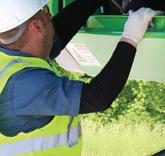





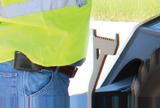



The Bass River Bridge has served as a vital transportation link on Cape Cod for nearly 90 years, connecting the communities of West Dennis and South Yarmouth along the traffic-choked Massachusetts Highway 28 corridor since the mid-1930s.
But nine decades of use does not come without serious wear and tear. A quick peek beneath the structure reveals crumbling concrete pilings, exposed rebar and chipped crossmembers. Up top, hundreds of cars drive over the cracked concrete deck each day.
The bridge was classified as structurally deficient and considered in poor condition by the Federal Highway Administration (FHWA) in November 2021, according to data provided by the agency.
Due to these structural deficiencies, the state Department of Transportation (MassDOT) is performing maintenance on the bridge, with a $40 million project to completely replace it scheduled for bidding later this year, the Cape Cod Times learned.
Jeffrey Colby, the director of public works for the town of Yarmouth, said maintenance

on the bridge will include “significant” work on the underside concrete slabs and pilings as well as the deck, extensively reinforcing the structure until the time comes when construction can begin to totally replace the bridge.
He does not expect any replacement to get under way until the spring of 2025.
Bids to install a new bridge are scheduled to go out this fall, Colby explained.
“There’s a several month time period in
which bidders are responding, then there’s the award process, and that type of thing takes a while with MassDOT projects,” he added.
Most of the repairs to the Bass River Bridge will be done below the roadway surface, which will mean minimal impacts on traffic, MassDOT spokesperson John Goggin told the Times in an email. He said traffic delays will only “occur intermittently” and be announced in advance.
“Beyond typical road surface maintenance, reinforced concrete deck repairs will be performed to the underside of the existing deck slab as well as selective pile repairs,” Goggin added. “These are necessary to remove the existing barriers from the bridge and facilitate construction phasing.”
The bridge is safe in its current state, but structural deficiencies are better handled in
see BRIDGE page 10
Connecticut is set to receive millions of dollars in funding for local projects that are part of the first offering of bills to fund the federal government — with likely more on the way if Congress negotiates and passes the second round later this month.
The U.S. Senate took the final step March 8 to approve a package of bills to fund six of 12 government agencies and avoid a partial shutdown.
President Joe Biden is expected to sign the legislation into law. Federal lawmakers need to pass funding for the remaining six by March 22.
As part of the appropriations bills, members in both chambers can submit requests to direct funding for priorities and pet projects in their states and districts, formerly known as earmarks. Billions of dollars were approved for earmarks in the first offering and make up less than 3 percent of the total funding package.
So far, Connecticut’s delegation has secured about $138 million in funding, with more expected in the next package of bills. That includes earmarks for a range of about 140 projects across the state, including infrastructure, affordable housing and environmental investments, among others.
Towns and cities saw a months-long delay of earmarked funding because Congress had been unable to pass appro-
priations bills for fiscal year 2024. Lawmakers instead approved several short-term bills, known as continuing resolutions, to keep the government running until they negotiated a spending deal in recent weeks.
More broadly, the legislation funds six agencies including: agriculture; commerce; energy; interior; military construction and veterans affairs; and transportation and housing.
“This package does not reflect every one of our priorities, but I am proud that in a divided country, we were able to work across the aisle to get this done for the American people,” said U.S. Rep. Rosa DeLauro, D-3rd District, who is the ranking member of the House Appropriations Committee, which helps craft government funding bills.
More than 60 towns and cities in Connecticut will see investments flow into their communities, the Connecticut Mirror reported March 9. Additional localities could be included in the second batch of earmarks, which could also include even more funding for places that already secured money for projects.
Overall, the earmarks are spread out and
reach the farthest corners of the state including Salisbury, Stonington and Thompson.
More than two-thirds of this batch will go toward infrastructure and transportation projects, while the remainder largely falls under economic development, social services, housing, energy and the environment.
So far, Hartford and New Haven are set to receive the most funding for projects. Among them are upgrades for museums like the Mark Twain House and Memorial and the Connecticut Science Center, both of which are located in Hartford.
Some of the highest-funded projects so far include:
• $4 million for improvements on Temple Street in New Haven;
• $3.6 million to help complete the Hop River State Park Trail around Coventry and Columbia;
• $4.5 million for upgrades to Mill River Park in Stamford;
• $3.2 million to repair a dike leak in Meriden; and
• $3 million for the construction of a new social services center in New Haven.
Housing projects also will see a sizable boost from this bill, particularly for affordable housing and homeless shelters. That includes investments to renovate a 12-unit affordable supportive housing apartment
building in New Milford, repairs to 14 affordable housing units in Washington, and funds to create housing in Waterbury, Winchester and Barkhamsted as well as in Windham and New London counties.
The first government spending package includes other priorities for Connecticut’s delegation like $2.4 billion for Amtrak — a portion of which will go toward enhancements on the Northeast Corridor — and $680 million to preserve the Long Island Sound, according to the Mirror.
U.S. Rep. Joe Courtney, D-2nd District, also noted that the legislation secures funding for projects at the Naval Submarine Base New London that he pushed for alongside others in the delegation.
Earmarks, now known in the U.S. House as community project funding and in the Senate as congressionally directed spending, have been back for a few years after a 10-year ban. Many lawmakers see them as direct ways of reaching their communities as well as wielding more influence during the appropriations process.
In the last spending bill that ran out at the end of last September, members secured a total of $236 million for more than 170 projects across Connecticut. It is unclear if lawmakers will exceed those numbers once the government is fully funded later this month.











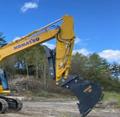
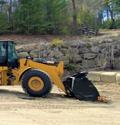




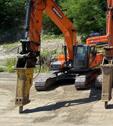








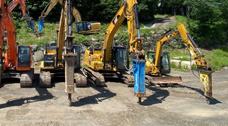









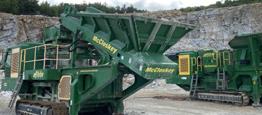


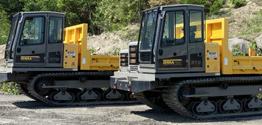










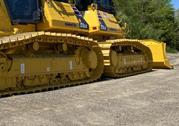



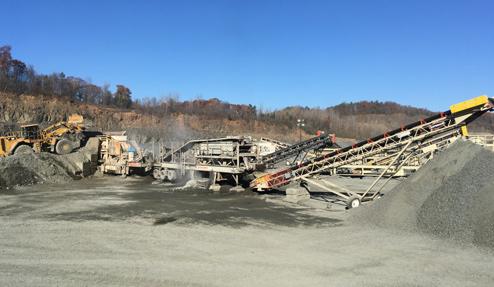

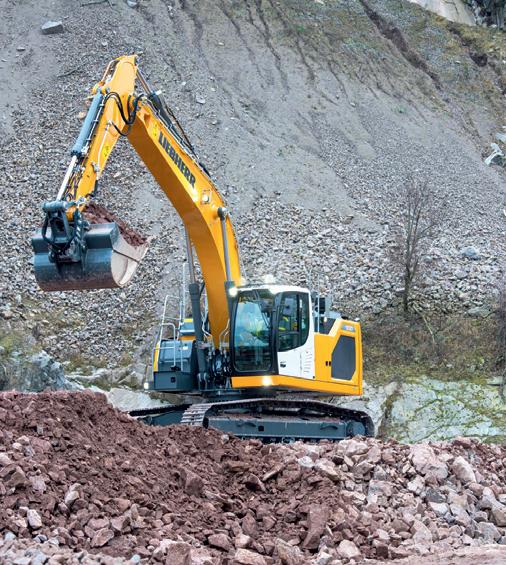
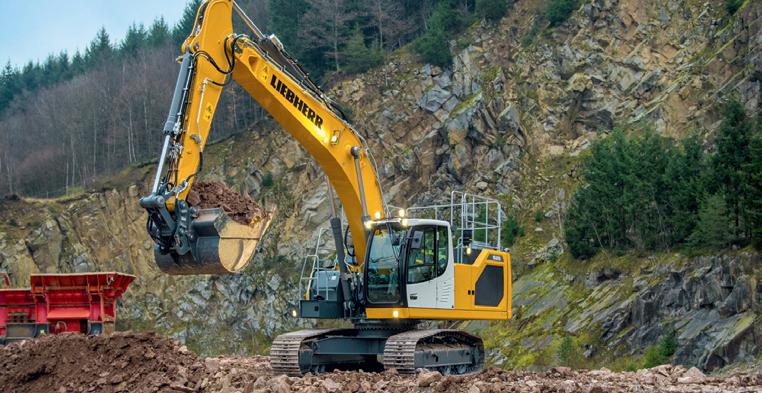
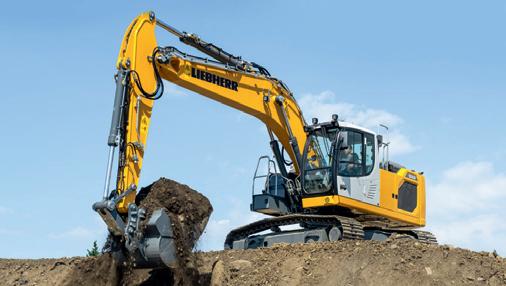
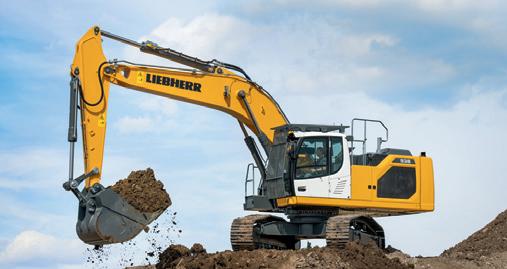


Liebherr completely redesigned its basic concept to offer customers more comfortable and intuitive products with even higher performance. The new Generation 8 crawler excavators feature more powerful engines for shorter load cycles and higher productivity, heavier counterweight for higher digging power and bucket capacities, all this while maintaining reduced fuel consumption.


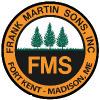






























U
Option 1: Get a














Y Yoou’re automa And now YO h
Option 2: Get 5 atically a winner wit have the power to ch a 5-year 3,000-hour w years of interest-fre

h our latest amazin oose your own prize, arranty plus cash in ee payments or 0% fin g deals on mini exc but don’t wait too lon
n your pocket up to $5 nancing for 60 month avators!













g, this offer is limited 5,500 depending on t s.* d! the model*
Either way, youu’ll get a winning machine that can do it all. Contact us today and T TAAKE 5 before it’s s gone!
DAM from page 1
River — upstream from homes and businesses along Wahconah Street and Bel Air Avenue, and potentially blocking a route to the county’s largest hospital — it is also categorized as a “high hazard.”
Massachusetts has declared it one of six abandoned or unsafe dams that has to go and set aside $20 million for its removal in December.
The Pittsfield news source noted that the best-case scenario for when the dam is to be removed is likely in 2025 or 2026, when heavy equipment and a small army of workers will pull apart the old earth and stone dike and haul away an estimated 355 tons of sediment contaminated with heavy metals — the toxic legacy of 19th century industrial New England.
The result would mean a free-flowing Housatonic River, and peace of mind for property owners who have had a wary eye on the dam for decades.
That process requires planning and permits, all of which are in progress.
Then there is the worst-case scenario, based on a U.S. Army Corps of Engineers (USACE) program designed to predict flood damage and spelled out in an emergency plan first compiled by the state Department of Conservation and Recreation (DCR) and updated by Pittsfield Mayor Peter Marchetti’s administration.
The state agency, which oversees the Office of Dam Safety, told the Eagle that it is keeping a close eye on the dam’s potential threats as it completes its studies, plans and permits.
From a computer simulation, the USACE determined that in the worst-case scenario, a deluge from a 100-year storm would send water over the top of the Bel Air Dam. Over half an hour, the embankment and retaining wall would finally give way, carving a trapezoidal-shaped gap in the dam and send a surge of water and sludge roaring downstream toward the North End, Wahconah Park and the West Side.
According to the simulation, the river would reach an astonishing maximum flow rate of 8,156.62 cu. ft. — more than 60,000 gal. — per second. At that speed, the impoundment pond — normally 24-acre ft., but given the scenario, likely closer to its maximum of 54-acre ft. — would quickly empty.
An immediate evacuation would be ordered, a notification would go out to the Massachusetts Emergency Management Agency (MEMA), and residents would be told to quickly move to higher ground or to the city’s available shelters.
In addition, the plan outlines which contractors to call, which streets to evacuate, and even shows how to properly fill and deploy sandbags.
But nothing could be done about the water, the Eagle reported.
In six minutes, according to the USACE simulation, the wave would reach its peak height of 1,006.95 ft. above sea level at Pontoosuc Avenue — more than a foot above the 100-year flood level of 1,005 ft. above sea level.
In half an hour, the water would have made its way to Pittsfield’s West Side and dissipate in another 30 minutes in the vicinity of the CSX railroad bridge, 1.85 mi. downriver and south of West Street. There, the simulation puts the highwater mark at 994 ft. above sea level, according to the report.
Under the dry-weather scenario, a breach also does not come with a happier ending, but the wave hits at a less violent speed. In this scenario, it takes an hour for the dam to breach, and another 16 minutes for water levels to crest at Pontoosuc Avenue.
Either way, there is flood water and mud everywhere, much of it likely contaminated with lead, chromium, and arsenic — all heavy metals used in the woolen industry.
“It would be catastrophic for that part of the city,” Sammons told the Eagle.
However, Pittsfield city officials have prepared. Meetings and training have focused on the dam’s condition and how the city would respond, and the department’s deputy chiefs and firefighters at the nearby Pecks Road station are well aware of the dam’s condition, he said.
While officials are grateful that the state came through with federal funding last year, that sense of relief comes with crossed fingers. With every significant rainstorm, residents and state and local leaders have one eye on the Bel Air Dam.
The Eagle noted that three inspections of the dam in 2023 by the state’s Office of Dam Safety, including one in July following an eight-day period that saw 5.43 in. of rain in Pittsfield, reported “no indication that the embankment was overtopped,” though water was observed at the top of the dam. Inspectors said they saw “significant flow through masonry joints observed on the downstream face of the dam.”
But based on visual comparisons to past inspections, “there was no obvious indication of masonry blocks that had washed out of the dam, or accelerated displacement of the dam,” inspectors from Norwood, Mass.-based GZA GeoEnvironmental wrote in a report.
Still, the most recent evaluation from the firm returned failing grades, with the word “UNSAFE” included in all caps for emphasis. No fewer than 17 previous deficiencies are cited, with the first reading, “Movement of stone masonry (bulging) on the downstream face of the auxiliary spillway appears to have occurred since the last inspection.”
The Eagle reported that GZA GeoEnvironmental’s study said the dam’s problems cannot all be seen in a visual inspection, and simply will not improve.
“Such deficiencies are not capable of self-correction and, over time, are expected to only worsen as compared to earlier inspections and reports,” the engineering report added.
For its part, the Connecticut DCR told the Eagle that it has one eye on the dam and the other on obtaining permits to remove it. Recently, its consultants appeared before the Pittsfield Conservation Commission and were granted permission to collect riverbed samples. Their goal was to find the soil strength of the riverbed once the dam is removed so they can design a new one.
According to a DCR spokesperson, the agency has sought a Notice of Ecological Restoration from state environmental regulators. The Bel Air Dam removal effort qualifies for expedited review, and once that is complete, it will need permits from the Connecticut Department of Environmental Protection, the Pittsfield Conservation Commission, and the USACE. But DCR also recognizes that it is racing the clock. The agency said it is “conducting routine inspections of the dam until the removal work can begin. This allows us to monitor and take any necessary remedial action to address maintenance needs during this process.”
the long term by replacing it rather than continued maintenance.
“A bridge replacement project is the most efficient method of eliminating these deficiencies,” he explained. “It will also improve other non-structural features of the bridge like lane configurations, sidewalks and railings.”
Colby said the replacement project will take place in phases, the first being the replacement of one half of the bridge while maintaining traffic flow on the other portion, before switching the work to the other half of the structure. Pedestrian and bike traffic also will continue throughout construction.
“[The prime contractor would be] committed to keeping two lanes of traffic open on that bridge at nearly all times,” he explained. “If there’s an opportunity to go down to one lane or alternating traffic, they’ll have to let us know about that.”
And because the bridge site on Cape Cod is along a busy tourist route, no maintenance or construction will be done during the summer, Colby said.
“They’re not allowed to work or impact traffic throughout that period; that’s why they have the timing of this repair work,” he added. “Doing work in January is not ideal, but they have to have things done before Memorial Day.”
As one of only three crossings of the Bass River, the bridge carries significant traffic during the summer tourist season and provides an important link year-round between the towns east of the river and Cape Cod Hospital in Hyannis, according to MassDOT.
It has one travel lane in each direction and only a single sidewalk located on its southern side. Though safe for everyone, the bridge is reaching the end of its useful lifespan and must eventually be replaced.
MassDOT describes the Bass River Bridge replacement and intersections project as one that will not only improve the highway as it passes over the bridge and through the main streets intersection in Yarmouth but will “provide multimodal access along the corridor while improving safety and comfort for all users.”
The state agency proposes to widen the bridge deck from 49 to 60 ft. to include two travel lanes in each direction, new shoulders, a sidewalk on the northern side of the bridge, a shared-use path on the southern side, and new ornamental light fixtures and railings on both sides of the structure.
The new bridge will have a higher vertical clearance and fewer piers than the current one, and the distance between piers will be widened from 18 to 54 ft.
In addition, the junction of North Main Street and Station Avenue also will be addressed as they presently intersect at an acute angle, creating a poor sight distance. MassDOT believes that improvements at these intersections will create more safety for all users.

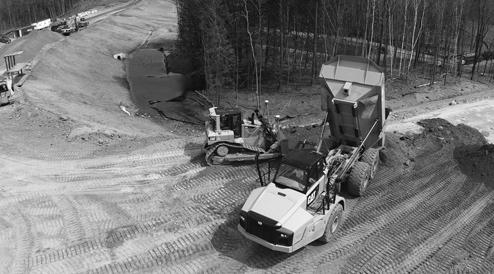
The project will construct a new interchange on I-93 in Londonderry, approximately 1 mi. north of Exit 4 that will provide access to the east side of I-93 via a new connector road that will be called Old Rum Trail. The work on I-93 is approximately 1-mi. long and proceeds into Derry.
According to NHDOT, the three construction projects include one that proceeds from exit 4A on I-93 and the connector road to the Derry/Londonderry town line; from the town line to just east of the intersection of Tsienneto Road and NH Route 28; and from just east of this intersection to the intersection of Tsienneto Road and NH Route 102. The only work that has been completed thus far is on the first project, which is 45 percent complete.
“We are half done with the sound abatement wall,” said Adam Bates, project manager of Weaver Brothers Construction. “The northbound ramp is completed with permanent pavement on it, which will be used for a temporary traffic detour.”
Weaver Brothers Construction also is working on the bridge portion of the project.
“A new bridge is being constructed over the highway,” Bates said. “The bridge is a 300-foot span over the highway that will connect with Old Rum Trail. All substructure for the bridge is done. The next step is to set the girders, which will be completed later this month.”
The construction equipment being used on the project includes two Caterpillar 349 excavators; four Caterpillar 745 rock trucks; two Caterpillar D6 dozers; two Caterpillar 336 excavators; and a John Deere 772 motorgrader.
NHDOT reported the benefits of the project will be to reduce congestion and improve safety along NH Route 102 and promote economic vitality in the Derry/Londonderry area.
The state’s legislators strongly support the project.
“Projects like this one are crucial for improving the transportation experience of travelers and supporting the local economy here in the Granite State,” said Sen. Jeanne Shaheen.
“This project will promote increased economic growth in the vibrant Londonderry and Derry business communities and improve access to downtown Derry,” said Sen. Margaret Hassan. “I was proud to support this project as governor and look forward to the benefits it will create for the region,”
Work on the project began in September 2022 with an October 2024 completion date set. CEG
(All photos courtesy of Weaver Brothers Construction Company.)

